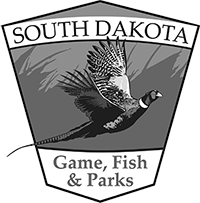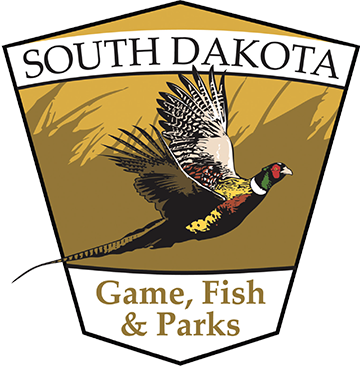Private Shooting Preserves
The Private Shooting Preserves Permit Application can be issued to an individual (South Dakota residents only), co-partnership, association, or corporation owning, holding or controlling by lease or otherwise any contiguous tract of land (must touch at the corners or sides) of at least 160 and not to exceed 2,560 acres.
A shooting preserve may not be located within one mile of publicly owned land managed for hunting and wildlife without prior Commission approval. The one-year private shooting preserve fee is $100.00 for the preserve season plus 40 cents for each acre of land within the preserve.
- For example, the annual fee for a preserve of 640 acres would be $356.00. The three-year private shooting preserve fee is $300.00 for the three preserve seasons plus $1.20 cents for each acre of land within the preserve.
The shooting preserve season runs from September 1 until March 31 of the following year. Shooting hours are restricted from sunrise until sunset. The game birds that can be licensed for South Dakota preserves include pheasants, partridges, quail, and turkey.
- The bag limits will vary for each species.
- The applicant is required to submit a plan of operation which includes information about the facilities available on the preserve, services offered, species of game birds to be hunted, bag limits planned, number of birds expected to be released, age of birds at time of planned release, and approximate dates of planned bird releases.
- The applicant must provide a full legal description of the acres involved, listing the section(s), township, range, and county.
- The preserve boundaries must be outlined on a plat map provided with the preserve application.
- A FSA (SCS) type aerial photo outlining the preserve boundaries is also required.
- A minimum of 300 rooster pheasants must be released within the preserve during the first year of operation and a minimum of 600 rooster pheasants each season thereafter.
- Hen releases are allowed on the preserves, but their numbers cannot be included on the game release records, nor can they be used to meet the required minimum release total for the preserve.
The total harvest of released and wild birds cannot exceed 100% of each species of birds released.
- For example, if 800 pheasants (680 marked and 120 wild) were harvested on the preserve, release records must show that at least 800 rooster pheasants have been released on the preserve acres.
All birds released on the shooting preserve must be marked by either toe clipping or by the enlarged nares from some type of anti-pecking device. In either situation, this marking must be done before the birds are six weeks of age. A department representative must verify the marking method and release of the birds. All birds must be kept until they are at least 15 weeks of age. Species of game birds hunted and tagged on the preserve may include only those species listed on the preserve permit. All birds must be released on preserves from August 1 through March 31.
Birds must be released on the preserve before hunting can be started. Waterfowl and other game species not listed on the preserve permit may be hunted within the preserve, but only with the appropriate licenses and during legal seasons, according to state laws and regulations.
All birds, both released and wild, harvested on preserve acres must be tagged with a GFP issued serial numbered kill tag. These tags are used to identify birds harvested on preserve acres. Any bird harvested on non-preserve acres should not be tagged.
A preserve hunter may transport or be in possession of up to 20 undressed or processed pheasants with attached kill tags from the beginning of the hunting preserve season through the end of the statewide pheasant season. From the end of the statewide pheasant season through the end of the private shooting preserve season, a preserve hunter may transport or be in possession of up to 15 undressed or processed pheasants with attached kill tags. Possession of more than 20 tagged pheasants will be allowed, provided the hunter can document multiple days of hunting on a preserve operator's guest register record.
Game harvest and release records must also be maintained and recorded daily throughout the entire preserve season by the operators. The harvest records will include the dates the hunters hunted, their names/addresses, driver's license numbers, and number/type of birds harvested. The release records will include the date(s) of release, species, sex, number released, and source of the birds.
Throughout the entire preserve season, shooting preserve kill tags must be placed around the leg or neck of all birds (released and wild) that are harvested on a preserve, even during the normal state season. Any birds harvested on non-preserve land are not to be tagged. Preserve operators must send in a request for shooting preserve kill tags (500/pkg.) in advance of the September 1 opening or prior to when they start hunting. There is a charge of 25 cents for each kill tag used, which is paid at the end of the preserve season, when left-over tags are returned with the game harvest and release records. Unused tags not returned, are assessed a fee of $2.00 each.
New and renewal applications for private shooting preserves will be received in the Pierre office from January 1 through March 1. Any new preserve application and those preserve applications located within one mile of the publicly defined land, must have a public notice printed in various daily newspapers prior to the approval or denial consideration of the Wildlife Division Director. The one mile distance permitted from public land is measured in a straight-line distance from the preserve to the closest point of the public land managed for wildlife and/or hunting. If you are considering setting up a shooting preserve, please contact your local wildlife conservation officer and discuss your plans before applying for a private shooting preserve permit.
Administrative Rules for Private Shooting Preserves
Sales Tax Information
State Laws for Private Shooting Preserves
Residents
One of the following licenses would qualify a resident to hunt small game on shooting preserves for the calendar year:
- Resident Small Game License ($33.00),
- Resident Combination License - small game and fishing ($55.00),
- Resident 1-Day Small Game License ($12.00),
- Resident Youth Small Game Licenses - ages of 12 through 15 years ($5.00), or
- Resident Junior Combination License for fishing, small game, and trapping - ages 16 through 18 years ($27.00).
A license purchased for the year 2016 will be valid through 1/31/2017 and a 2017 license can be purchased on 12/15/2016 and is valid through 1/31/2018.
Nonresidents
Nonresident Shooting Preserve Licenses:
- One Day Preserve License - $46.00
- Five Day Preserve License (five consecutive days) - $76.00
- Annual Preserve License - $121.00
Any of the following licenses are valid on private shooting preserve acres for the birds listed on the operator's permit:
- Any of the three shooting preserve licenses.
- Resident and nonresident small game license.
- Youth small game license.
- Valid dates listed above are the same for any of these mentioned licenses.
Youth:
Nonresidents who are at least 12 years of age, or will turn 12 by December 31, may apply for or buy licenses and may hunt in any open season beginning September 1. Non-residents younger than 12 cannot hunt in South Dakota. To buy a license, nonresidents under 16 need a copy of their hunter safety certificate or a copy of a previous hunting license issued to them from any other state.
Private Shooting Preserves by Size
| Acreage | Number |
|---|---|
| 160 | 24 |
| 161-320 | 40 |
| 321-640 | 53 |
| 641-960 | 32 |
| 961-1279 | 18 |
| 1280-1919 | 36 |
| 1920-2559 | 18 |
| 2560 | 9 |
Private Shooting Preserve Renewals
| Year | Not Renewed | Renewed | New | Total |
|---|---|---|---|---|
| 2012-13 | 12 | 185 | 18 | 203 |
| 2013-14 | 16 | 187 | 14 | 201 |
| 2014-15 | 18 | 183 | 14 | 194 |
| 2015-16 | 13 | 181 | 19 | 200 |
| 2016-17 | 17 | 183 | 14 | 197 |
| 2017-18 | 2 | 195 | 19 | 214 |
| 2018-19 | 17 | 199 | 26 | 225 |
| 2019-20 | 23 | 202 | 13 | 215 |
| 2020-21 | 15 | 201 | 29 | 229 |
| 2021-22 | 14 | 210 | 16 | 226 |
| 2022-23 | 16 | 208 | 19 | 227 |
| 2023-24 | 13 | 214 | 21 | 234 |
| 2024-25 | 28 | 208 | 27 | 235 |
Private Shooting Preserve Pheasant Harvest and Release Records
| Year | Number of PSP | Species | Birds Released | Total Birds Harvested | Released Birds Harvested | Wild Birds Harvested |
|---|---|---|---|---|---|---|
| 2010-11 | 207 | Pheasant | 356,727 | 242,705 | 185,094 | 57,611 |
| 2011-12 | 297 | Pheasant | 386,563 | 243,196 | 200,337 | 43,744 |
| 2012-13 | 203 | Pheasant | 403,380 | 237,965 | 202,991 | 36,630 |
| 2013-14 | 201 | Pheasant | 434,005 | 260,426 | 234,590 | 25,836 |
| 2014-15 | 194 | Pheasant | 420,074 | 268,316 | 234,003 | 34,313 |
| 2015-2016 | 200 | Pheasant | 432,304 | 279,383 | 243,168 | 33,196 |
| 2016-17 | 197 | Pheasant | 438,287 | 280,536 | 250,029 | 30,507 |
| 2017-18 | 214 | Pheasant | 468,668 | 283,254 | 264,291 | 18,963 |
| 2018-19 | 225 | Pheasant | 499,442 | 305,987 | 279,243 | 26,74 |
| 2019-20 | 215 | Pheasant | 499,179 | 306,430 | 283,988 | 25,316 |
| 2020-21 | 213 | Pheasant | 451,662 | 276,571 | 252,597 | 23,974 |
| 2021-22 | 226 | Pheasant | 579,672 | 350,581 | 330,674 | 21,104 |
| 2022-23 | 227 | Pheasant | 597,137 | 359,535 | 338,488 | 21,047 |
| 2023-24 | 234 | Pheasant | 612,857 | 375,716 | 354,133 | 21,863 |
Private Shooting Preserve Other Game Bird Harvest and Release Records
| Species | Birds Released | Total Harvested | Percentage |
|---|---|---|---|
| Partridge | 5863 | 1413 | 25% |
| Quail | 210 | 21 | 10% |
| Turkey | 0 | 0 | 0% |

